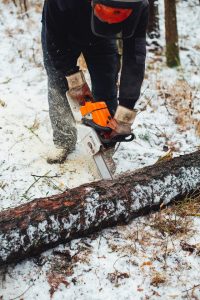Reducing Slips, Trips and Falls in the Logging Industry, Part 1
Re-printed from The Loggers Voice Summer 2022
(Part 1 of 2)
by Brie Weisman, OTR/L with Maine LogAbility 
Improvements in logging technology are making the industry safer and more efficient. One surprising consequence of the shift from muscle to machine is the increased risk of slips, trips, and falls (STFs) in certain situations.
Increasingly, mechanized harvesting techniques mean that many workers spend much of their day in temperature controlled cabs, manipulating joysticks to harvest wood they need never touch. These technical advances have lessened the level of fitness required to be a logger. Obesity, old age, and compromised mobility are no longer insurmountable barriers to work in the field. In fact, many loggers can no longer count on the rigors of the workday to help them maintain basic levels of fitness.
This is significant. While mechanization lessens the amount of loggers risking falling on a steep slope with chainsaw in hand, reduced athleticism increases risk of STFs on any terrain, and increases the likelihood that those falls will result in injuries. Old age, extra
weight, and general reduced fitness are all factors that dramatically increase risk of STFs and resultant injuries.
If you doubt that STFs are serious enough to merit addressing, consider: An astonishing 30% of lost time logging incidents are due to STFs, with 3% resulting in deaths. Balance that against the fact that they are among the easiest, cheapest safety concerns to address.
Before we talk about prevention, let’s get some definitions on the table.
Slip: Loss of balance due to loss of friction between your seat, grip, or foothold. Even without an associated fall, a slip can result in an injury from a violent wrench to your muscles from the effort to stay upright, or from flailing arms or feet striking something sharp or hard.
Trip: Loss of balance from an unexpected disruption of motion due to contact, most often by foot, with an object, or by an unexpected drop in surface. Injuries occur in manners similar to slips.
Fall: Loss of balance resulting in an uncontrolled drop to the ground or collision with an object, such as tripping and striking a tree.
While most STFs end with little more than a grunt and embarrassment, even short falls while standing or walking can end in injury. The majority are minor sprains, strains, or bruising, but a not insignificant number of STFs end in injuries requiring treatment, with a few ending tragically in permanent disabilities or death. Common sense dictates taking reasonable precautions to eliminate these hazards.
- Maintain fitness. Fit people suffer fewer STFs and fewer injuries from the STFs they inevitably have.
- Stretch. Staying limber increases balance and agility, lessens injuries, improves recovery time.
- Maintain good posture. Good posture = good balance. We’re often stiff after long sessions seated in a machine or vehicle, so take a moment to stretch and unkink when finally getting out. Think military: chest out, shoulders back, head up.
- Wear proper eyewear. Glare and bright sunlight cause fatigue and accidents beyond STFs. Sunglasses are essential safety gear.
- Wear proper footwear for you, the task, and the weather. Footwear = tires for people.
- Be aware that medications may inhibit coordination, balance, or focus. Ask your doctor if alternate medications may have weaker side effects, or if taking medication on a different schedule might work better for you.
- Look out. Scan for trip hazards, slick surfaces, uneven ground. (look ahead briefly rather than constantly looking down at the ground immediately before you-trust your visual memory.)
- Take care whenever carrying or moving heavy or cumbersome objects. Hold objects close to reduce strain and improve balance.
- Stay focused. Pause work during phone use or other distractions. 10.Learn to fall safely. (This is easily learned and surprisingly effective at preventing injury.)
STFs will always be part of logging. But we can eliminate much of the lost time, injuries, and still worse tragedies caused by STFs by maintaining a safe work environment and expecting responsible preparation and best practices from our workforce. In the next issue of VOL we’ll discuss how to fall correctly, and the best exercises and stretches for strengthening the core to reduce the number of STFs and the severity of injuries caused when they do occur.
